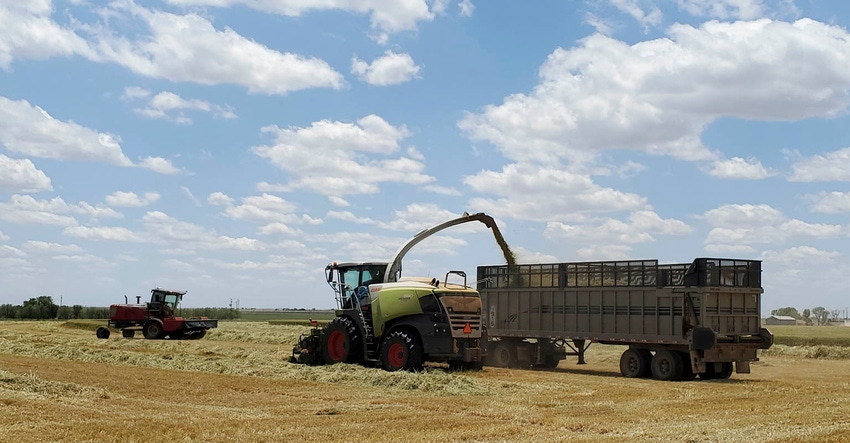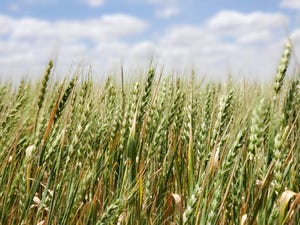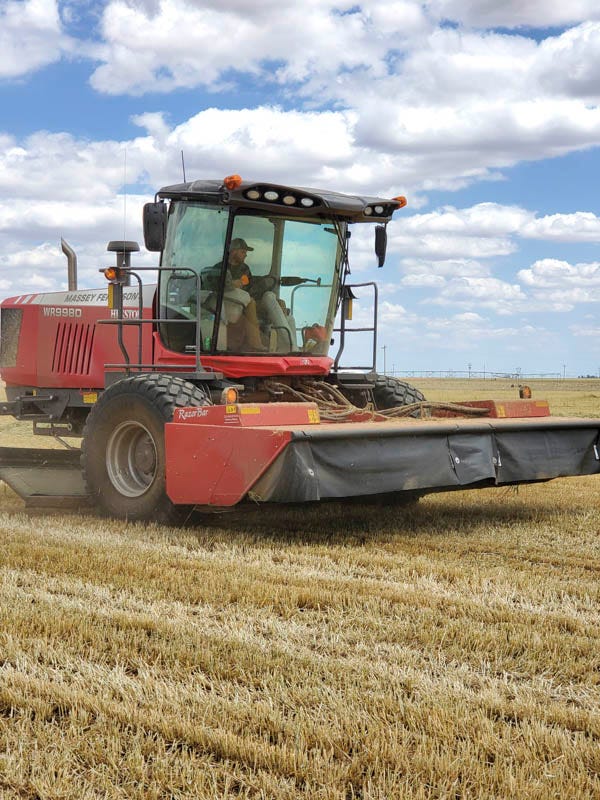
An increasing demand for wheatlage contracts by dairies for ensilage is causing a dilemma for High Plains producers.
Drought conditions in the southwest Panhandle are creating a potential forage deficit in the region, and this is driving up the demand and price for forage silage, said Jourdan Bell, Texas A&M AgriLife Extension Service agronomist, Amarillo.
This could mean fewer producers will be taking their wheat crop to grain harvest, opting instead to cash in on diverse forage options for livestock producers, including wheatlage.
Wheatlage is the process of cutting and ensiling wheat as a silage crop to preserve forage quality, Bell said, and is one of the cheapest forages to produce. Wheatlage is generally chopped when wheat is at the soft dough stage and forage moisture is favorable for fermentation.
 Carefully examine ensilage contracts. Harvest timing a major concern. (Photo by Shelley E. Huguley)
Carefully examine ensilage contracts. Harvest timing a major concern. (Photo by Shelley E. Huguley)
Because wheatlage provides an opportunity for producers to harvest earlier and possibly go back with a second crop or even a summer silage such as corn or forage sorghum, if they have the well capacity, there are more people looking at it as an alternative to straight grazing or grain, said Rick Auckerman, AgriLife Extension agriculture and natural resources agent for Deaf Smith County. Wheatlage is typically harvested in April, whereas the wheat going to grain is harvested in June.
Auckerman said a producer planning to contract wheatlage will typically plant higher seed populations and plan for potentially more irrigation in drier years.
“We know there are contracts out there for our producers, but we are cautioning producers to investigate before committing, as the terms may not be favorable,” he said.
Wheatlage contract concerns
The number of dairies has gone up, and there is a greater demand to contract silage, Auckerman said. If the dairies don’t get wheatlage contracts, they’ll have to look to more expensive corn and sorghum silage to make up the difference.
A major concern is the harvest timing, Bell said. The contracts are requesting the wheat silage be chopped at the boot stage, not the typical soft dough stage, and dried to 62% moisture, which is not advantageous for the farmer.
Green chop wheat is generally cut at the boot stage, when the head is still enclosed in the flag leaf sheath, and the moisture content at this stage is approximately 80%, she said. It is either fed directly or wilted in the field prior to ensiling. This earlier maturity stage optimizes forage quality because crude protein and digestibility are greater.
“After studies over the past several years, we know quality is impacted by environmental conditions, specifically water stress,” Bell said. “And our results confirm that the nutritive value at boot is greater than the nutritive value at soft-dough.”
Therefore, harvesting at boot is desired by the dairy to access the higher crude protein and get a lower acid detergent fiber, ADF, she said. ADF is a measure of the lignin and cellulose, which are the least digestible component of forages.
“This is advantageous for the dairy, but not the forage producer,” Bell said.
Auckerman explained that the producer would be losing a lot of money, because based on tonnage, the dairies are not offering more money to reflect the higher quality of the forage. Instead of direct chopping into the truck, as it is typically done in this region, the dairies want the green chopped wheat laid down on the field to dry down from 80% to 60% moisture before moving it.
“That’s an added expense and operation for the producer,” he said. “A happy medium as far as quality issues and tonnage would be to harvest at soft dough.”
Essentially, Bell said, the dairies are securing a premium forage without compensating the farmer for lost yield. If the contract is paid on delivered weight, the farmer is losing an additional 20% due to forage dry down.
“Our research in Dallam County has shown that forage production at boot is only about 50% of the production at soft-dough,” said Mike Bragg, AgriLife Extension agriculture and natural resources agent for Dallam and Hartley counties. Bragg participated in the forage trials with Bell the past two years. “At soft dough, the early grain development, as well as added biomass, contributes to higher yields, although quality is reduced.”
Ensilage concerns
Bell said the dairies are looking for forage at about 65% moisture because it can be ensiled. The ideal moisture content for silage varies depending on the ensiling method. In the Texas High Plains, most silage is in drive-over piles. If moisture content is greater than 65%, the dry matter is low. High moisture/low dry matter silage does not ensile properly, and clostridia and butyric acid can form in the silage. Additionally, seepage losses can be an issue in the High Plains’ drive-over silage piles.

“Poor quality silage results in nutrient losses from the silage as well as reduced intake from the herd,” she said. “Conversely, we do not want the silage too dry. If the silage is less than 60% moisture, the dry matter is high. Long, dry material is difficult to compact and traps oxygen, which also results in fermentation losses.”
So, when harvesting at boot, the solution is either to directly feed as green chop because the moisture content is too high to ensile or dry the forage in the field until the moisture content is ideal for ensiling.
“While forage contracts are very important for Texas High Plains producers, we advise producers to consider negotiating a price that accounts for the forage nutritive value in addition to harvest stage and moisture,” Bell said. “Farmers should ensure they are fairly compensated.”
Source: is AgriLife TODAY, which is solely responsible for the information provided and is wholly owned by the source. Informa Business Media and all its subsidiaries are not responsible for any of the content contained in this information asset.
Read more about:
EnsilageAbout the Author(s)
You May Also Like




